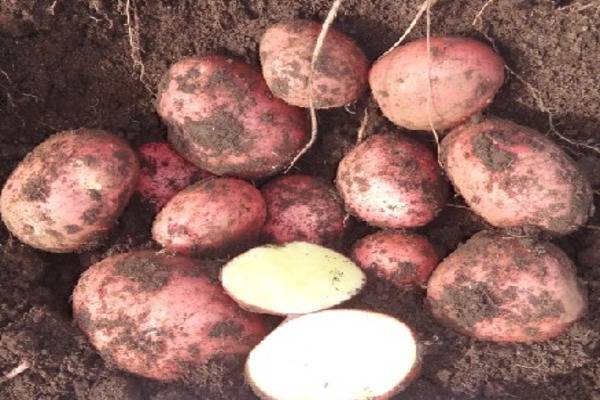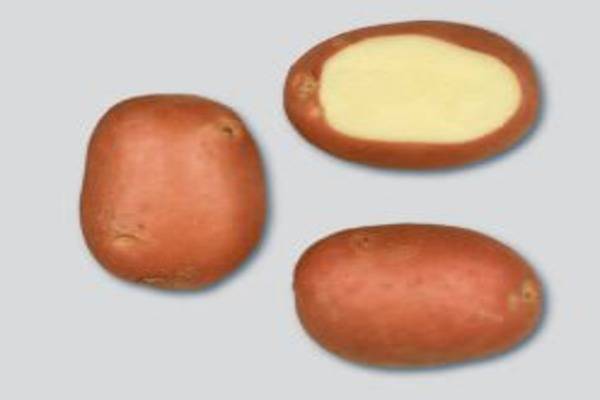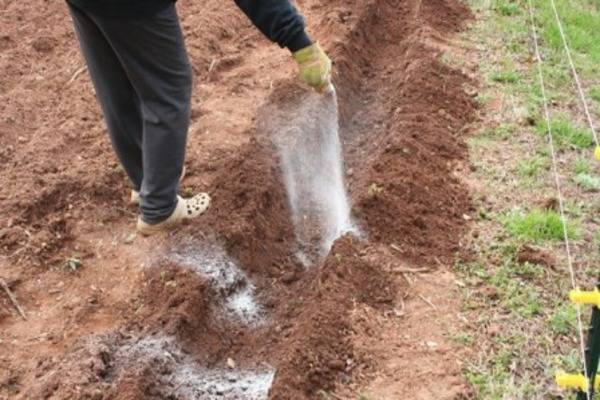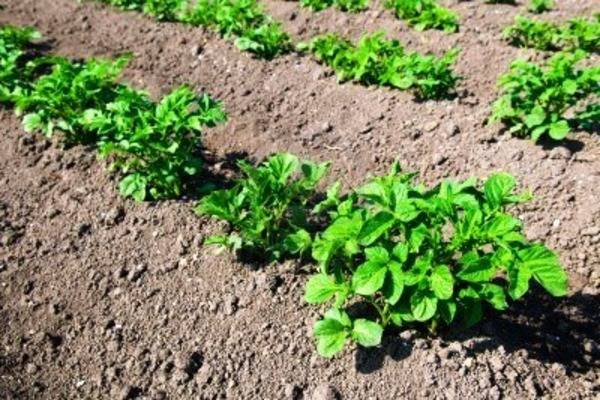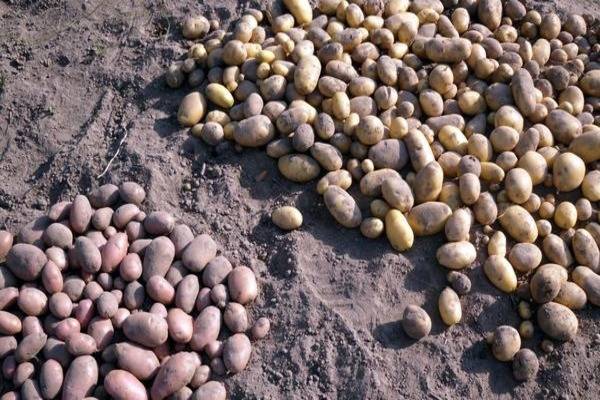Content
Dutch potatoes Mozart varieties belong to table varieties. It has proven itself excellently when grown in the North-West, North-Caucasian, Central Black Earth, Central and Volga-Vyatka regions of Russia, Ukraine and Belarus.
Description
Mozart bushes grow in different heights (from medium to high) and are formed by erect or semi-erect stems. The reddish, purple-tinged flowers appear rather large. Leaves are usually medium in size.
Root crops ripen 80-110 days. In one bush, 12-15 potatoes weighing 100-145 g are formed. The peel of the Mozart variety is red, and the pulp is yellow (as in the photo). According to summer residents, potatoes are not very boiled, they have a pleasant taste and are well suited for preparing a variety of dishes. The starch in the root crops of Mozart potatoes is in the range of 14-17%. This variety is excellently stored for a long time (keeping quality 92%).
Advantages and disadvantages
Mozart potatoes are popular among summer residents and farmers due to their simple agricultural technology and many other advantages:
- excellent taste;
- medium early formation of tubers;
- excellent commercial qualities;
- resistance to drought and heat;
- tubers tolerate long-term transportation well due to their high resistance to damage;
- insensitive to potato crayfish, scab and golden nematode.
The disadvantage of the Mozart variety is its low resistance to late blight.
Landing
As soon as the weather is warm, you can start planting Mozart potatoes. To harvest a high harvest, several activities are carried out:
- In the fall, they prepare a plot allocated for potato beds. Carefully removed weeds, the remains of vegetable crops. The soil is covered with a thin layer of compost and watered with EM-preparations (Baikal-EM-1, Shining, Revival), which improve the soil structure, heal the soil, destroy pathogenic bacteria, increase the mineral nutrition of plants and the quality of Mozart fruits. After that, the soil is loosened. Such compost "dusting" of the soil speeds up the ripening of the crop by about two weeks.
- For planting, tubers are carefully sorted: only large, whole and healthy ones are selected. To accelerate the germination of potatoes, the seed is placed in a warm, lighted place until powerful shoots appear. Long shoots should not be allowed to grow, otherwise they will simply break off when planting. Mozart potato planting material is sprayed with disinfectants (Prestige fungicide) and growth stimulants (Poteytin, Epin, Bioglobin).
If a small area is planted, then the holes can be made with a shovel. A common planting scheme: row spacing - 70-80 cm, in a row, the distance between the pits is 30-35 cm.To maximize the germination of the Mozart seed, wood ash is laid in each hole, a little earth mixed with humus.
Care
Only timely and proper care of potato plantings will guarantee a good and high-quality harvest.
The soil around the potato bushes should always be soft to allow air to reach the roots. The first time the beds are loosened 5-6 days after planting the Mozart potato tubers. And the process is repeated as needed - as soon as a dry crust forms on the surface of the soil.
The frequency of watering is determined by the climatic characteristics of the region. If cool rainy weather is established, then there is no need to additionally moisten the soil.In dry weather, a slight wilting of the tops is a signal of a lack of moisture. In order to properly saturate the soil and provide water for planting Mozart potatoes, it is recommended to pour about 45-50 liters of water per square meter of the plot area.
In regions with hot dry summers, it makes sense to organize a drip irrigation system for potatoes.
It is better to irrigate plants in the morning.
Hilling and feeding
The selection and planting of seed are important stages in the cultivation of Mozart potatoes. But to get a high yield, you need to pay attention to the beds throughout the season.
Hilling features
Experienced gardeners recommend to huddle the Mozart potato beds twice a season. The first time the bushes are treated when the stems grow about 20 cm high.This procedure is repeated when the potato tops become 35-40 cm high.
If the need arises, then hilling is done more often. After all, this event significantly affects the yield of the Mozart variety. Thanks to hilling, the earth is loosened and the roots receive air. Earthen ridges allow additional tubers to be set. Loosening of the soil prevents its rapid drying, at the same time weeds are removed.
If the temperature is high, then it is better to set aside the morning time for the procedure and pre-moisten the potato beds.
How to fertilize
The Mozart potato variety belongs to the medium-late, therefore, it especially needs feeding during the period of growing green mass and tying tubers. It is most effective to use a local method of fertilizing. Thus, nutrients will go directly to the root system.
In order not to be mistaken with fertilization and to get a good yielding result, it is recommended to feed Mozart potatoes three times per season:
- During an active growing season, a mixture of humus (15 glasses) and urea (10 tsp) is used. This composition is sufficient for processing a ten-meter potato row.
- To stimulate the formation of buds and flowering of the Mozart variety, a combined composition is used: 30 tbsp. l of wood ash is mixed with 10 tsp of potassium sulfate. The dose is calculated for a 10 m long garden bed.
- To make tubers more active, use a solution of mineral fertilizers: in 10 liters of water, dilute 2 tbsp. l superphosphate and potassium sulfate and 1 tbsp. l nitrophoska. Half a liter of fertilizer is poured under each bush.
It is not recommended to use organic matter during flowering of Mozart potatoes, as this causes increased weed growth.
Diseases and pests
The development of diseases in Mozart potatoes is caused by fungi and bacteria. The most common are:
| Signs of the disease | Treatment methods | |
| Late blight affects the leaves of the Mozart variety. Appears after flowering bushes | Favorable conditions are cool rainy days. The first symptoms are dark brown spots on the lower leaves. The whole bush gradually decays | The main way to fight is preventive measures. The rules of crop rotation are observed, tomatoes are not planted nearby. Spraying Mozart potato bushes with chemicals is effective - a solution of a mixture of copper sulfate and Bordeaux liquid |
| Blackleg - bacterial disease | The lower part of the stem turns black. Favorable conditions are cool, humid weather. Tops and tubers rot | Diseased bushes are removed from the roots. Prevention: seed material is warmed up and germinated before planting. Mozart potato tubers are also dried before storage. |
| The Colorado potato beetle gnaws at the leaves of the bushes. The main harm is caused by the larvae | Adult insects hibernate in the soil and appear when the air warms up to + 12-18˚С | The insects are collected by hand.Spraying of potato beds with chemicals is also used: Tsimbush, Dilor, Volaton |
Harvesting
Approximately 15-20 days after flowering, it is recommended to tilt the stems at a height of 10-15 cm from the ground. In order not to stop photosynthesis, and the plant does not wither, the stems of Mozart potatoes do not completely break. This technique can significantly increase the yield of potatoes. Since the plant substances will not fully enter the top of the bush, but "return" to the roots. But this method can only be applied to healthy plants.
As soon as the lower leaves of the tops turn yellow, you can mow it. After 7-10 days, potatoes are started to be dug. The crop is not immediately harvested for storage. In dry weather, the tubers are left on the field to dry. If the weather is wet or rainy, then it is better to spread the Mozart potatoes under cover. The crop must be sorted. Separately selected tubers for future planting. Do not leave damaged, sluggish or diseased potatoes for the winter.
For storage of the crop, wooden containers that are ventilated are suitable. The boxes are installed in a dark, dry, cool room.
